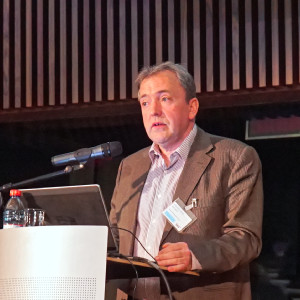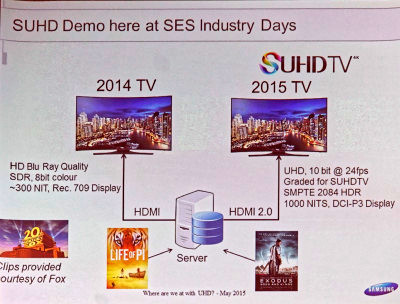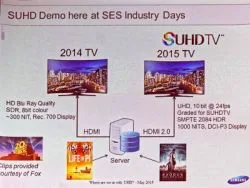 John Adam of Samsung was the next speaker and he gave the “set makers'” point of view. He said that consumers are buying UHD sets and that is also driving the growth of sets in 55″ and above.
John Adam of Samsung was the next speaker and he gave the “set makers'” point of view. He said that consumers are buying UHD sets and that is also driving the growth of sets in 55″ and above.
He also said that there have been a lot of UltraHD trials and people really could see the difference in content when it was presented in UltraHD.
IP OTT providers are changing the landscape by not waiting for the broadcasters and there has been a lot of development in this area especially of UltraHD boxes in France from Free and Bouygues Telecom.
The Digital Europe logo was based on the expectation that displays would need to work with an STB. Adam went through the requirements of the label programmes and he described the labelling scheme as an “interoperability point”. The intention was to allow interoperability of UltraHD STBs and sets. Sets are available now and consumers are buying them.
However, he acknowledged that there are real challenges in creating and delivering content to the sets that are in the market.
Adam said that the UHDTV Alliance is open, contradicting the earlier EBU comment and he invited the EBU to get involved.
Samsung wants to sell its UltraHD sets which it is labelling as SUHD and these sets are in store now with quantum dots for wide colour gamut, HDR and UltraHD. Peak brightness is 1,000 cd/m² and the features will cascade down the product line over time. At the moment, it is only the top of the range sets that have these features.
 Adam surprised delegates by saying that 50% of TV sales in Europe in 2015 will be in UltraHD for Samsung.
Adam surprised delegates by saying that 50% of TV sales in Europe in 2015 will be in UltraHD for Samsung.
He went through the Blu-Ray UltraHD features. Blu-ray will be able to deliver genuinely premium content and he believes that this will “give new life to packaged media”.
Current HDMI is effectively supporting the DVB UltraHD Phase 1 requirements along with HDR and that could have been a barrier if it hadn’t done so.
Adam said that all the extra data needed for HDR and HFR will be beyond the capabilities of the current HDMI 2.0 and new hardware is needed to deliver. That may be a problem for HDMI.
On the other hand, SuperMHL has been developed and that looks like a good potential interface for set makers.
Adam said that the BBC proposals for HDR could be really good for broadcasters as the current Samsung sets could deliver that level of performance and might be upgradeable (although this might involve a module upgrade, rather than just firmware).
Analyst Comment
At the event, Samsung showed one of its new SUHD sets running HDR content using the BBC EOTF and graded for the 1,000 cd/m² that the sets produce. The effect was dramatic compared to the reference unit, which was a top of the line Samsung 2014 set. Adam’s argument that the BBC approach (which uses, effectively, a very simple extension to Rec 709 gamma curve and would be relatively easy to implement) would be good for broadcasters is a good one.
 HDR Content that was graded for the 1000 nits of the new Samsung set on the right.
HDR Content that was graded for the 1000 nits of the new Samsung set on the right.
Also during the event, SES announced that it was conducting the first live broadcast of UltraHD with the BBC EOTF and it was shown on the Samsung sets. Sadly, as the new Samsung sets were not available when the content was graded, it had been graded for the 600 cd/m² of last year’s TVs. As a result, there was not a great deal of difference between the image quality on the two sets (unlike the other demonstration, which was dramatic). However, the demonstration did show that the older model of TV was perfectly able to display a good quality image, without modification. For broadcasters, that’s compelling.
 This was a first HDR Broadcast. The image on the left is showing how a standard 2014 TV can work well with content using the BBC EOTF
This was a first HDR Broadcast. The image on the left is showing how a standard 2014 TV can work well with content using the BBC EOTF
There was some discussion after the talk including some discussion about HDMI vs MHL. Adam can foresee that MHL could survive on TV sets even when MHL is not used in mobile (I had pointed out that Samsung has dropped MHL support from the Galaxy 6). When we privately suggested that HDMI had possibly come to the end of its road, he didn’t argue. (BR)

